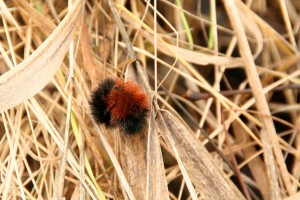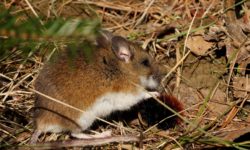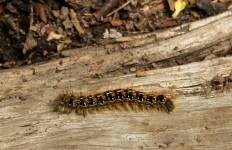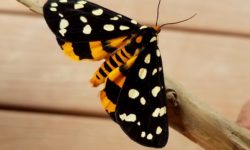What will winter be like? Many look to the woolly (wooly) bear caterpillar for a prediction. The black and orangish-brown banded caterpillars may be the most widely recognized creature for predicting winter.
According to folklore, if the woolly bear caterpillar has more black area than orangish-brown then the winter is going to be long, snowy and cold. If the caterpillar possesses more orangish-brown area then the winter is going to be mild.

Woolly bear caterpillars curl up in a ball to protect their soft underparts. Striped skunks are the only animal patient enough to pluck each bristle off in order to eat the caterpillar.
Many factors determine the coloring of the woolly bear caterpillar and one of the most influential is how last winter ended. To better understand the woolly bear caterpillar’s coloring, we have to look at its life cycle.
Woolly bear caterpillars, like most insects, progress through four stages in their life: egg, larva, pupa and adult. In autumn when woolly bear caterpillars are seen the most frequently on roads and sidewalks, they are nearing the end of their larval stage as a caterpillar.
The caterpillars seek out shelter in winter hibernacula under leaves, in rock crevices and under bark. When temperatures increase in the spring to a certain point, the woolly bear caterpillars emerge from their hibernacula and briefly eat before spinning a cocoon to pupate.
The cocoon is fashioned from the bristles (called setae) of the woolly bear caterpillar–which aren’t woolly feeling at all– and are held together by silk. After one to two weeks a dull, orange-yellow Isabella tiger moth emerges. The two-inch wingspan is speckled with small black spots.
Caterpillars are the only stage at which the insect has chewing mouthparts. So the main purpose of the moth is to mate and lay eggs (if female). Once the eggs hatch (five to twelve days), the larval (caterpillar) stage begins again.
As the woolly bear caterpillar eats vegetation, such as dandelions, birch, clover and maples, its skin becomes tight. The caterpillar’s growth is limited by its exoskeleton which can’t increase in size. Therefore, the woolly bear caterpillar molts up to six times before maturity.
Before each molt, a new, larger skin grows underneath the current exoskeleton. When ready, the woolly bear sheds the older, outer skin. With each new molt, an additional orangish-brown segment is added to the exoskeleton. Therefore, younger woolly bear caterpillars have a shorter orangish-brown band than older caterpillars.
If the spring was mild and the caterpillars had a chance to emerge early, the new caterpillars of the year have more time to grow. With a long growing season, the woolly bear caterpillar would have a longer orangish-brown segment than if it was an late spring or early fall.
In reality, the orangish-brown segment on the woolly bear caterpillar indicates whether the last winter was long or short.
Another factor influencing the segments on the woolly bear is rain. If the caterpillar endures wetter weather, more black setae are produced.
Whether last year’s winter corresponds to the upcoming winter is anybody’s guess. But informal research since the 1940’s has determined that the folklore of the woolly bear caterpillar’s coloring has been right 70 percent of the time.




